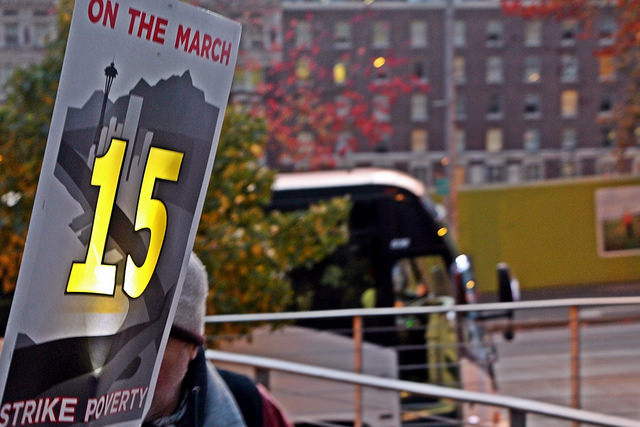Today, the federal NDP is slated to use its Official Opposition Day to table a motion that would have Parliament Hill vote on a proposal to reinstate the federal minimum wage, which has been dormant since 1996.
The motion asks parliamentarians to consider incrementally raising the federal minimum wage to $15 an hour over a five-year period.
For a while there, it looked like it would never happen — a Canadian $15 minimum-wage movement.
South of the border, Americans have been rallying for a $15 minimum wage for over a year. This month, workers walked off the job and protests took place in an estimated 150 American cities in an effort to raise that country’s low federal minimum wage (it’s $7.25 an hour) to $15.
There have been victories. In Seattle, the newly elected mayor committed to raise the city’s minimum wage to $15 an hour and is well on the way to making that reality.
But here in Canada, the minimum-wage debate has been trapped in a time warp. The federal minimum wage was abandoned in 1996. In Canada, it’s been up to the provinces and territories to determine the legislated, mandated minimum wage that an employer is expected to pay employees.
And provincially, any attempt to increase the minimum wage on a steady basis has been overly cautious, muted by a loud and powerful business lobby.
In Ontario last year, the provincial government took cover under an appointed panel to look into how to set its minimum wage. That consultation process was rocked by a consistent, coordinated grassroots campaign to lift Ontario’s minimum wage to $14 an hour. To no avail. The government settled on $11 an hour, with a promise to peg it to inflation every year moving forward.
Yes, the minimum wage is inching upward in most Canadian provinces, but it pales in comparison with what a living wage would actually be. For instance, in Toronto, CCPA Economist Hugh Mackenzie and Unifor Economist Jim Stanford calculated the living wage to be $16.60 an hour in 2008. It would be higher today, to reflect the rising cost of living.
So it is an interesting development to see federal NDP Leader Thomas Mulcair announce that his party will campaign on re-awakening the idea of a $15 federal minimum wage.
The question before Parliament today is an important one. There are several reasons why a $15-an-hour minimum wage would be a welcome starting point.
First of all, it would represent the boldest minimum wage in Canada — bolder than any Canadian province or territory. I know. How sad is that?
It’s the beginning of a national conversation about the inadequacy of the current minimum-wage level.
It’s the beginning of a national conversation about the value of a minimum wage that is a living wage — one that can actually help a household pay all of its most basic bills, such as housing, transit to work, child care, and food.
Last year, we at the CCPA-Ontario recommended that the Ontario minimum wage be pegged at 60 per cent of the average industrial wage. Why? Because the lowest paid worker in the labour market should be paid in relation to what the rest of workers are paid. That’s only fair.
Federally, CCPA-Ontario Economist Kaylie Tiessen estimates that a minimum wage set at 60 per cent of the average national industrial wage would be $14.49 an hour — given the average wage in Canada was $24.15 in 2013 (CANSIM Table 282-0070). A $15 federal minimum wage would do the trick.
That still falls short of many living wage calculations in Canada. But as a symbolic gesture, it’s important.
And for those federal workers who would benefit from a raise — those workers who are playing by all the rules but struggling to scrape by — it would be more than a symbolic gesture; it would be a meaningful contribution to their household bottom line.
A $15 federal minimum wage in Canada, regardless of how many (or how few) workers in federally regulated companies or agencies it might help, is a good starting point.
It helps set a new tone for the value of decent work in Canada. A decent minimum wage — one a worker can live on — is vital to any prime minister or premier who expresses the political will to reduce income inequality in Canada’s labour market.
Hopefully it’ll give the provinces the political courage they’ve been lacking to pursue a similar goal.
Learn more about the value of a living wage here.
Trish Hennessy is director of the Canadian Centre for Policy Alternatives’ Ontario office (@CCPA_Ont) and part of the national office’s Growing Gap team. Follow Trish on twitter: @trishhennessy.
Photo: Toby Scott/flickr



